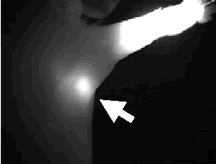Home > Health & Education > eAdvances
Quantum Dots Could Guide Surgeons: February 11, 2004Tracking the spread of tumors is a tricky business. Surgeons perform biopsies on nearby lymph nodes to determine if the cancer has spread, but this can cause serious side effects. Now, researchers led by Dr. John V. Frangioni of the Beth Israel Deaconess Medical Center and Harvard Medical Center have developed a novel imaging method that employs a technology called quantum dots (QDs) to pinpoint the sentinel lymph node closest to the tumor. By removing and evaluating this single lymph node, surgeons can significantly reduce the trauma of lymph node biopsies. In the January 2004 edition of Nature Biotechnology, Dr. Frangioni and Dr. Moungi G. Bawendi of the Massachusetts Institute of Technology, along with their colleagues, describe how the tiny, synthetic QD particles can be used to pinpoint sentinel lymph nodes in mice and pigs, allowing for precise and easy excision. The QD technique may also improve visualization of cancer cells. The body’s bean-shaped lymph nodes collect and filter the nearly colorless lymphatic fluid that bathes and drains the tissues. The lymph nodes’ primary job is to trap and remove harmful substances, such as cancer cells, from the body. To find the sentinel node, the lymph node closest to a tumor, surgeons typically inject a blue dye and a radioactive tracer in the vicinity of the tumor, and then use a radioactivity detector to pick out the general location of the sentinel lymph node. Once an incision is made, the blue dye, localized to the lymph node, provides further guidance. Still, the technique is imprecise, and surgeons often have great difficulty locating the sentinel lymph node. If not found, many lymph nodes must be removed and sampled, potentially leading to lymphedema, among other side effects. Dr. Frangioni’s group is among the first to explore the potential medical applications of quantum dots, which are nanometer-sized metallic crystals that can be manufactured to emit light at specific wavelengths in response to illumination. For this study, the researchers chose emission in the near-infrared spectrum, because skin and other tissues are partially transparent at this wavelength, allowing direct visualization of QDs from the outer surface of tissues. Furthermore, the scientists engineered the QDs by shielding them in an organic coating and tweaking the synthesis so that the particles would be approximately 15-20 nanometers in size—the right size to flow freely through the lymphatic vessels but still be trapped by lymph nodes. When injected into the thigh of a pig, a small amount of QD solution quickly collected in and illuminated the sentinel lymph node, allowing it to be surgically removed with a minimal incision. Further development of QDs might ultimately eliminate the need for radioactive tracers and dyes and minimize exploratory surgery. Because QDs congregate in the same part of the lymph node as cancer cells typically do, their bright emission could allow pathologists to narrow their search for cancer cells. Dr. Frangioni and his colleagues are now evaluating the use of QDs to image sentinel lymph nodes in animal models of colon cancer, melanoma, and breast cancer. But before the procedure could be evaluated in patients, the manufacture of quantum dots would need to be refined. QDs today are composed of toxic metals, although the researchers saw no evidence of toxic effects on the animals tested. “Most previous work with quantum dots has been done in organic solvents, but we’re exploring the potential of quantum dots in bodily fluids,” says Dr. Frangioni. Ultimately, that will mean adjusting the chemistry to eliminate toxicity. Dr. Frangioni would also like to modify the surface of QDs in hopes of uncovering an even broader application—targeting the tumors themselves. One problem with cancer surgery is uncertainty that the cancer has been completely removed. Even small cancerous fragments that escape notice can reseed a tumor. Quantum dots that brightly illuminate cancerous tissue could greatly improve the success of cancer surgery. Partial funding for this research comes from the National Institute of Biomedical Imaging and Bioengineering (NIBIB) via an Exploratory/Developmental (R21/R33) Grant to Drs. Frangioni and Bawendi. These grants support innovative, sometimes high-risk research projects that have the potential to significantly advance biomedical imaging or bioengineering. NIBIB, the newest institute at the National Institutes of Health, was established in 2001 to improve human health by promoting fundamental discoveries, design and development, and the translation of enabling technologies to biomedical imaging and bioengineering. “The type of research we are doing is what NIBIB was created for—a collaboration between chemists and engineers, with the potential to improve patient care,” says Dr. Frangioni. “NIBIB resources were incredibly important to getting this work done.” Additional support for this research was provided by the National Science Foundation, the Office of Naval Research, the Department of Energy, the Stewart Trust of Washington, DC, and the Korea Science and Engineering Foundation. Reference: Kim S, Lim YT, Soltesz EG , De Grand AM, Lee J, Nakayama A, Parker JA, Mihaljevic T, Laurence RG, Dor DM, Cohn LH, Bawendi MG, Frangioni JV. Near-infrared fluorescent type II quantum dots for sentinel lymph node mapping. Nature Biotechnology 22:93-97, 2004. |
 |
 |
Department of Health and Human Services |
 |
National Institutes of Health |
 |





